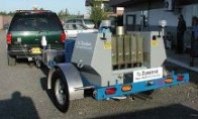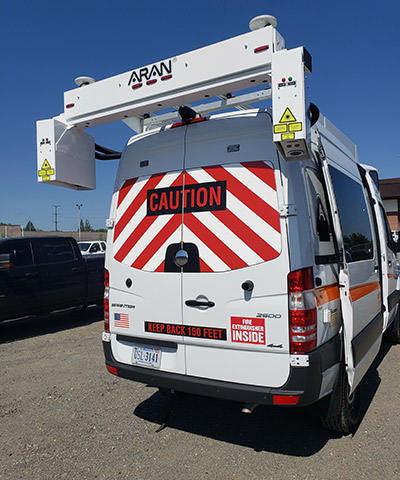Pavement Management and Preservation
Airport Pavement Condition Reporting
INTRODUCTION
This is an accumulation and summary of airport pavement information to serve as an aid in effective airport pavement management. Pavement condition surveys are performed each year on approximately a third of the 55 Civil Airports on this system. Conditions are rated according to the Pavement Condition Index (PCI) methods as described in ASTM International (ASTM) D5340, Standard test Method for Airport Pavement Condition Index Surveys. This method gives a PCI of 100 for a perfect, new pavement. Deductions are made for measured pavement distresses so that a completely failed pavement would have a PCI of 0.
Pavement Management for airports includes PCI inspections of pavement surface conditions every third year. The inspections involve visual assessment of representative sample units to quantify the extent and severity of various distresses (cracking, raveling, depressions, etc.). The inspection information is entered into a PAVER database to generate a Pavement Condition Index (PCI) value along with construction/maintenance histories.
Predictions of pavement conditions, results of previous surveys, construction histories and pavement inventories are stored in the Corps of Engineers computer program: PAVER, Version 7.1.1. PAVER is being used to implement an Airport Pavement Management Program according to AC 150/5380-7B. Similar pavement types and uses are grouped together to create "family curves" for predicting deterioration of the PCI as a function of time and to produce recommendations for future projects to optimize the life cycle of airport pavements.
The Pavement Management Program is entering its third year of implementation and the results of the implementation effort to date can be viewed in this report 6MB.
General recommendations for pavement maintenance and project work are provided to Aviation Planning along with maps of PCI and age. These are used as strategies to identify needed work as well as predicted pavement conditions through the PMP implementation and report.
The principal set forth here recognizes that pavement maintenance is most efficient and cost effective when done at higher condition ratings. When the PCI falls below minimums, it is most cost effective to rehabilitate the pavement with construction contracts. However, lack of funding and need for safe operations sometime require that stopgap maintenance be performed on pavements in lower condition categories.
SUMMARY
Guidelines set by the Alaska State Legislature ask us to maintain minimum PCI condition ratings of 70 for runways and 60 for taxiways and aprons. Climatic variations, funding and remoteness provide a continuous challenge for maintenance and construction needs of our airports.
Federal funding availability for airport improvements and maintenance is sometimes dependent on the service level of an airport. Airports are classified by service levels that are dependent on annual enplanements and typical use of the airport. Enplanement counts indicate the number of aircraft passengers at an airport in a given year. Those that have more than 10,000 annual enplanements are classified as Primary airports. Those with less than 10,000 annual enplanements serving commercial air passengers are classified as Carrier Service airports. Airports with less than 10,000 annual enplanements and without regular commercial airline service are classified in the General Aviation service level.
AIRPORTS PAVEMENT CONDITION DATA
PDF format over 500K free Adobe Reader download
MAINTENANCE DEFINITIONS OF RECOMMENDATIONS
Guideline for Determination of Action to be Taken for a Given PCI Rating |
||
|---|---|---|
Runways |
Taxiways/Aprons |
Action |
| 100 - 70 | 100 - 60 | Preventative Maintenance |
| 69 - 40 | 59 - 40 | Corrective Maintenance/Rehabilitate |
| 39 - 0 | 39 - 0 | Reconstruct |
The recommendations shown are based on maintaining the airports at the Legislative standards. Below are brief definitions and descriptions of practices needed for the various pavement recommendations.
Preventative Maintenance: includes crack sealing, crack filling and minor patching with hot or cold mix. It is used to prevent further deterioration of the pavement. Preventative maintenance will typically raise the PCI by 5 to 10 points.
Crack sealing with equipment and rubberized materials specifically made for pavement crack sealing is superior to using plain asphalt cement, asphalt emulsions or cutbacks. Use of plain asphalt products poured into cracks will seal them for only a year or so. Crack sealing using experienced crews with proper equipment and crack sealing materials will often remain serviceable for over 5 years. Suppliers and District Maintenance Managers can recommend the specification that will best meet the needs for a particular use.
Besides the typical "tar pot" heater with application wand, crack-sealing equipment includes a hot compressed air lance that blows out debris from the cracks and heats it, removing moisture. Some airports use routers to get cracks to a constant depth and width for sealing. If snow plowing and brooming tends to remove the crack sealant, it must be kept below the surface road elevation, filling the routed areas or wider cracks to approximately 1/8" below the surface. If crack sealant is applied above the pavement elevation, it is best to squeegee it smooth on the surface. Apply crack sealants according to the manufacturer's recommendations, using local experience.
Unfortunately, there is not one method or set of materials that will work everywhere in Alaska. However, it is recommended that most crack sealing be done with a trained crew with proper equipment and materials. That can be a mobile crew that works on many airports under the direction of the District and Airport Managers.
Wider cracks, greater than ¾" in width will need filling before applying sealants. Use of backer rod in the bottom of these wide cracks is necessary to prevent excessive use of crack sealants. Very wide cracks will require use of cold or hot mix asphalt. This work is more like Corrective Maintenance.
Corrective Maintenance: is used when pavement distresses such as depressions, swells, raveling, and high severity cracks are found. It is used to repair localized pavement failures generally by patching. Placing patches may simply require placing hot or cold mix in the problem area. However, sometimes distressed areas must be cut out and patched full depth. Use of a tack coat will help bonding between existing pavement and the patch. Sometimes corrective maintenance may require placing a seal coat to repair oil spills, raveled areas or severe grader scrapes. Corrective maintenance can bring the pavement conditions up to minimum standards.
Overlays can be used to improve structural capacity of the pavement. This work is outside the realm of normal maintenance and is usually done with a project. The best chance for long-term performance of an overlay is when it is done on a surface that is in good condition. Cracking on the existing pavement will normally reflect up through an overlay within 3 years of construction. An overlay will bring the PCI back up to 100, however, how long it performs well is dependent on the condition of the overlaid surface and further maintenance.
Rehabilitation: as shown here involves work on the existing pavement, followed by an overlay all done under contract. Work on the existing surface may include planing the surface smooth, patching and filling crack prior to overlaying. This work will bring the PCI back up to 100 and its performance is dependent on the quality of the work done on and as described for overlays.
Reconstruction: will include at least removal and replacement of the existing pavement. If the need for this occurs prematurely, then improvement of the structural section is warranted. That may include increasing the pavement thickness and/or stabilizing the base and subbase materials. This is project work that will bring the PCI back up to 100.
Stop Gap Maintenance: is work done on substandard pavement areas to get them to last until project work can take place. It may include patching, sealing and filling that is intended to maintain minimum serviceability but will have only small effect on the PCI. Stopgap maintenance is not considered a cost effective use of funds but is necessary when project needs are delayed.
Related Resources
- Transportation Asset Management
- Airport Pavement Management
- Highway Pavement Management
- Transportation Geographic Information Section (TGIS)
- Alaska Aviation System Plan
- Automatic Road Analyzer (ARAN)
- Federal Aviation Admistration
- Federal Highway Administration
- U.S. DOT FHWA Asset Management – Pavement
- The National Center for Pavement Preservation
- Transportation System Preservation Technical Services Program
Fugro ARAN
Fugro uses two Automatic Road Analyzer (ARAN) vehicles to collect the pavement condition data across the connected road system. Click the image below for more detailed information about the data collection vehicles.
Heavy Weight Deflectometer (HWD)
Trailered Dynatest HWD


